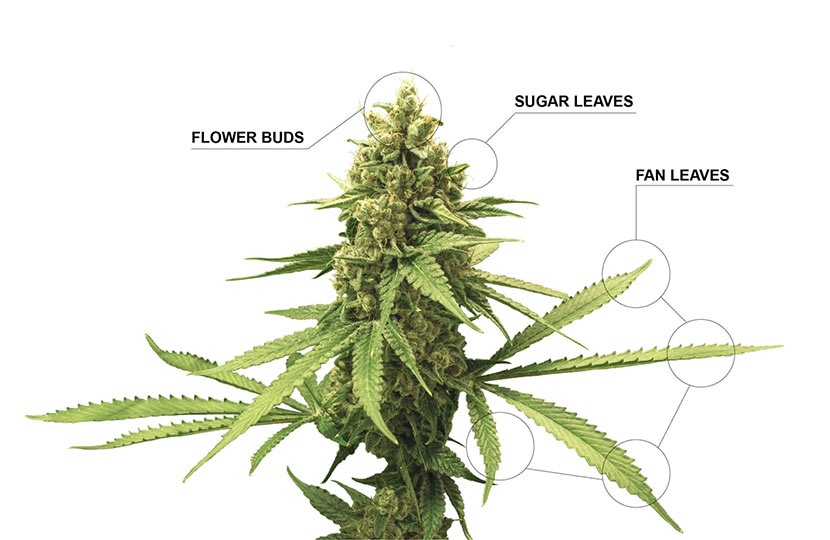Some people are content to just light up a preroll and enjoy the effects of cannabis. They don’t need to know anything beyond that. But not everyone is satisfied simply experiencing something without understanding more about it. Plenty of cannabis consumers are science-minded, and they may be curious to learn more about what makes this plant tick. Sure, we all know it’s bud we’re smoking. But what exactly is bud, anyway?
If you find yourself eager to know more about the things you enjoy, then perhaps you’d be interested in having a deeper understanding of this plant’s different parts. Fortunately, you’ve come to the right place, because we know quite a bit about cannabis anatomy, and we’re ready to break it down for you.
1
Seed
All cannabis plants start with the seed, so that’s where we’re going to begin. They come from the female plant and contain both male and female genes. Ranging drastically in size, cannabis seeds are round with a point on one end and another end that’s flat. During germination, a taproot will emerge, which later becomes the primary root for the plant. Germination isn’t guaranteed, meaning cultivators will have to master proper growing techniques to prepare cannabis seeds the right way.
2
Root
From a seed begins a taproot that will eventually become the root of the plant. This is what draws water and oxygen from the soil to nourish the growing cannabis. But that’s not the only function of roots. They are also responsible for holding sugars and starches generated during photosynthesis and for anchoring the plant.
3
Stem
The stem, also known as the stalk, is the main part of the plant from which all of the branches grow. Inside this rigid part of cannabis anatomy is a vascular system that allows moisture and nutrients to travel from the roots all the way to the leaves. The stem also circulates starches and sugars throughout the plant. A good way to encourage lateral growth and produce more bud is to trim the stem when it reaches five nodes.
4
Node
Cannabis nodes are where branches spring forth from either the stem or other branches. They are also responsible for determining whether a plant is male or female. Sometimes you will see buds or fan leaves sprouting from nodes. You can generally tell how tall a plant will be by how far apart nodes are from each other (otherwise known as “internodal spacing”).
5
Cotyledon Leaf
After a seed sprouts, the earliest leaves you will see are known as cotyledon leaves. Typically appearing in pairs, they are the first signifier that the plant will grow well.
6
Fan Leaf
If you’ve ever let your cannabis flag fly, then you know what a fan leaf looks like. That’s right, it’s essentially the symbol for cannabis culture. But despite the fact that they are the plant’s most identifiable leaves, they hardly have any resin and are thus typically trimmed away from the final product. This doesn’t mean they don’t serve a purpose, however; fan leaves absorb light, using photosynthesis to process that light into energy the plant needs to thrive. Indica strains usually have a higher concentration of these leaves than sativa strains.
7
Sugar Leaf
The small leaves that grow among buds are called sugar leaves. Unlike fan leaves, they are often used in cannabis products, as they are covered in resin.
9
Cola
No, cannabis doesn’t produce a fizzy drink you can enjoy on top of your head buzz, but it does have areas where buds grow in tight clusters known as “colas,” or “bud sites.” While colas may appear all throughout the lower branches, they are usually smaller than those that grow on top. Dubbed “main cola” or “apical bud,” the top of the plant is where most of the bud grows.
10
Pistil and stigma
The reproductive organs of a female cannabis plant are found in the pistil, along with stigmas, which are strands that resemble hair. Stigmas are what catch pollen from male plants, facilitating the reproductive process. The color of these strands starts out white and will take on a darker shade of yellow, red, brown, or orange as cannabis grows. While stigmas are essential to plant pollination, they aren’t particularly useful in products.
11
Bract and Calyx
The bract represents the cannabinoid motherlode. Shaped like tears, these leaves are where the female plant’s reproductive parts are located. There’s a high concentration of resin glands here, accounting for the extra potency. And hiding behind the bract is a transparent layer shielding the ovule known as the calyx.
12
Trichomes
We’ve discussed them before. They’re easily recognizable, giving strains that frosted appearance. Trichomes are loaded with all the goodness you expect from cannabis products. Rich with terpenes and cannabinoids, they’re not just for us to enjoy — they also serve as protection from natural hazards.
And there you go! Don’t you feel a bit more connected to your cannabis products after getting to know the plant a little better? Now go ahead and show off what you’ve learned to all of your friends. And perhaps the next time you’re in a dispensary, this information will help inform your shopping experience.
And there you go! Don’t you feel a bit more connected to your cannabis products after getting to know the plant a little better? Now go ahead and show off what you’ve learned to all of your friends. And perhaps the next time you’re in a dispensary, this information will help inform your shopping experience.

